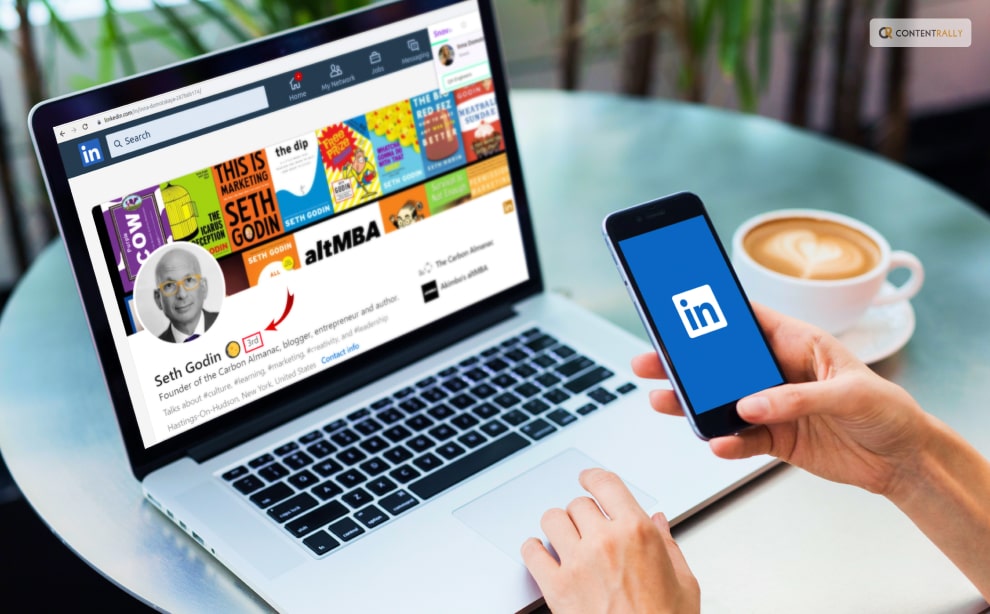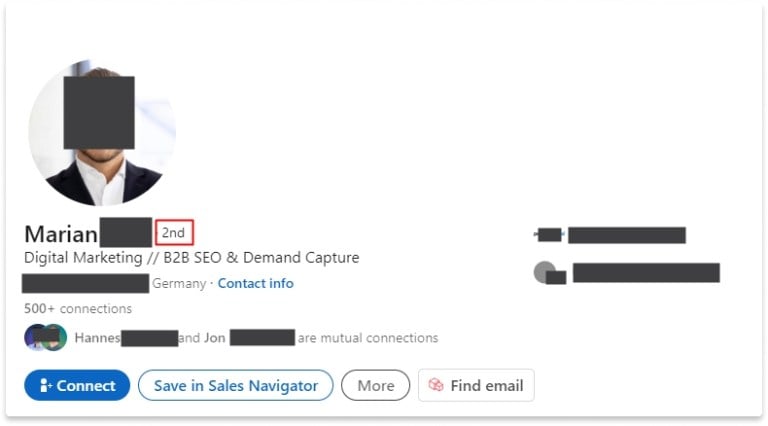LinkedIn is a powerful platform for professionals looking to network, find opportunities, and share knowledge. One of the key features of LinkedIn is the connections system, which allows users to build their professional network. Understanding how these connections work is essential for maximizing the platform's potential. There are different types of connections on
What Does 3rd Connection Mean?

In LinkedIn's terms, a *3rd connection is someone who is three degrees away from you in your professional network. To put it simply, if you are connected with someone (your 1st connection), and that person is connected to another person (your 2nd connection), then that other person’s connections are your 3rd connections. Here’s how that relationship breaks down:
- 1st Connection: People you are directly connected to. You can message them directly, see their connections, and share updates.
- 2nd Connection: People who are connected to your 1st connections. You can send them a connection request but can’t message them unless you have a premium account or they enable messaging.
- 3rd Connection: People who are connected to your 2nd connections. You usually cannot message them unless you’re part of the same LinkedIn group or have a premium account.
So why should you care about 3rd connections? Well, they can represent a broader networking opportunity. While you may not have a direct relationship, they can still be valuable for:
- Expanding Your Reach: 3rd connections can help you tap into networks you wouldn't reach otherwise. You could potentially connect with industry leaders, potential employers, or collaborators.
- Getting Introductions: If you see a 3rd connection who interests you, consider asking one of your 1st or 2nd connections for an introduction. This can often be a warm introduction, making it easier to start a conversation.
- Exploring Job Opportunities:* Many job listings or professional opportunities are shared within networks. By connecting with 3rd connections, you might gain visibility into job openings you wouldn't find otherwise.
Understanding how to identify and interact with your 3rd connections is crucial. While LinkedIn might seem daunting, it can be a goldmine for creating beneficial professional relationships. When you encounter a 3rd connection, take the time to check their profile, understand their professional background, and consider how you might mutually benefit from connecting. With a little effort, you can turn those 3rd connections into valuable relationships that may advance your career or broaden your knowledge.
Also Read This: Materials to Consider When Choosing Camera Lens Bags in 2025
3. The Importance of Network Tiers on LinkedIn

When it comes to LinkedIn, understanding the different tiers of connections can be crucial for maximizing your networking potential. The platform categorizes connections into three tiers: 1st, 2nd, and 3rd connections. Your 1st connections are people you are directly connected to; these are your closest contacts. Meanwhile, 2nd connections are friends of friends, serving as a bridge to a wider network. Then we have 3rd connections, which include the friends of your 2nd connections and can be valuable for expanding your outreach even further.
So why should you care about this tier system? Here are a few key reasons:
- Targeted Growth: By understanding the hierarchy, you can focus on expanding your 2nd and 3rd connections strategically, rather than just collecting random connections.
- Connection Relevance: When you engage with 2nd and 3rd connections, you can often find individuals who share common professional interests, which can lead to valuable relationships.
- Enhanced Visibility: Interacting within your network’s extended tiers can increase your visibility and credibility in your field, making you more approachable to potential collaborators or employers.
Networking is not just about quantity; it’s about the quality of connections. Knowing where your connections fall within these tiers helps you to approach the right people when looking for opportunities, advice, or collaboration. It’s about leveraging your existing connections to find new prospects and expand your professional circle effectively.
Think about it: every time you connect with someone, you’re not just gaining a single contact; you’re gaining access to their entire network as well. This exponential growth potential is where the real power of LinkedIn lies. Don’t underestimate the value of 3rd connections—many breakthrough opportunities come from the most unexpected places!
Also Read This: How to Delete a LinkedIn Message Safely
4. How to Identify Your Connections on LinkedIn
Identifying your connections on LinkedIn might seem straightforward, but there are some nuances to consider that can help you make the most of your networking experience. Here’s a quick rundown on how to spot the different connection tiers and use that understanding to your advantage.
To start, LinkedIn makes it fairly easy to see your connections. Here’s what you should do:
- Go to Your Profile: Click on your profile picture or the “Me” icon at the top right corner.
- Access Your Connections: From the dropdown menu, select “Connections.” This will take you to a list of everyone you’re connected with.
- View Connection Types: As you scroll through, you’ll see indicators next to each name showing whether they are a 1st, 2nd, or 3rd connection.
Now that you know how to identify your connections, it’s time to leverage that information effectively. Here are some ways you can engage:
- Engage with 1st Connections: Since these are your direct contacts, reach out with personalized messages or comments on their posts to maintain communication.
- Utilize 2nd Connections: If someone in your network is connected to someone you’d like to meet, consider asking for an introduction. A warm intro can significantly increase your chances of a successful connection.
- Tap into 3rd Connections: Even if they might seem distant, you can still engage publicly with their content. Commenting on their posts or sharing relevant articles can establish a rapport.
And let’s not forget the power of LinkedIn’s search functions. You can search specifically for 2nd or 3rd connections using filters, allowing you to find and connect with people who share your interests, industry, or geographical location.
In the end, the key takeaway is this: understanding your 1st, 2nd, and 3rd connections is essential for effective networking on LinkedIn. By actively participating with your connections and reaching out strategically, you’ll not only expand your network but also enhance your professional journey. Happy connecting!
Also Read This: Managing Multiple LinkedIn Company Pages What You Need to Know
5. Benefits of Connecting with 3rd Connections
When you're navigating LinkedIn, you might find yourself pondering the value of connecting with 3rd connections. At first glance, they may not seem as significant as your 1st or 2nd connections, but linking with these individuals can open up a treasure trove of opportunities. Let's dive into some of the key benefits of connecting with your 3rd connections on LinkedIn.
- Access to New Opportunities: 3rd connections can introduce you to job openings, collaborations, or projects that you might not have been aware of otherwise. They can serve as a bridge to new circles and industries.
- Diversity of Perspectives: Engaging with individuals outside your immediate network can provide fresh insights and different viewpoints. This can be invaluable, especially in creative fields or when brainstorming solutions to problems.
- Growing Your Influence: The more connections you have, the broader your network's reach becomes. As you connect with 3rd connections, you amplify your presence and increase your visibility within your industry.
- Strengthening Your Brand: Every connection carries a piece of your professional story. By connecting with diverse individuals, you not only enhance your professional presence but also showcase your willingness to engage and collaborate.
- Learning and Development: 3rd connections might have expertise or knowledge that you can tap into. By interacting with them, you can gain insights into new trends, tools, or strategies that can enhance your own skills.
In short, connecting with 3rd connections is about expanding your horizons. It’s like opening a door to a room filled with new ideas and possibilities. You never know what can come from just one connection!
Also Read This: Steps to View Your Own LinkedIn Profile as Someone Else Sees It
6. Strategies to Expand Your Network
Ready to grow your LinkedIn network and connect with those elusive 3rd connections? It’s not as daunting as it seems! Here are some effective strategies that can help you cultivate valuable relationships and expand your network.
- Engage with Content: Start by liking, commenting on, or sharing posts from potential 3rd connections. This can draw attention to your profile and lead to connection requests from those who appreciate your insights.
- Participate in LinkedIn Groups: Joining groups related to your industry or interests allows you to engage in discussions with others. It’s a great way to showcase your expertise and connect with members who might be 3rd connections.
- Send Personalized Connection Requests: When reaching out to 3rd connections, always include a personalized message. Briefly explain why you want to connect, and reference any common interests or shared connections.
- Attend Virtual Events and Webinars: Many professionals host events on LinkedIn. Participate actively, and you’ll likely meet new people. Follow up with attendees on LinkedIn after the event to connect.
- Leverage Alumni Networks: Don’t underestimate the power of your alma mater. Alumni often have a strong desire to support each other, so reconnecting with fellow graduates can lead to meaningful connections.
By implementing these strategies, you can effectively expand your LinkedIn network and tap into a world of opportunities with your 3rd connections. Remember, it's all about building those relationships one connection at a time!
Conclusion: Navigating LinkedIn Connections Effectively
Understanding and managing your LinkedIn connections can significantly enhance your professional networking experience. By actively engaging with your connections, you can foster valuable relationships that may lead to growth opportunities. Here are some key takeaways to consider:
- Be Proactive: Reach out to your 1st-degree connections and ask for introductions to their 2nd-degree connections; this is a great way to expand your network.
- Engage Thoughtfully: Like, comment, and share content from your connections to stay on their radar and showcase your insights.
- Personalize Connection Requests: When reaching out, always include a note explaining why you want to connect.
- Leverage Alumni Networks: Find and connect with fellow alumni who can provide you access to valuable 3rd Connections.
- Maintain a Professional Presence: Regularly update your profile with relevant skills and experiences that will attract prospective connections.
By strategically navigating your LinkedIn connections, you can unlock new avenues for career advancement and collaborative opportunities. Remember that each connection holds the potential for significant professional growth, so approach your networking journey with intention and authenticity.
 admin
admin








